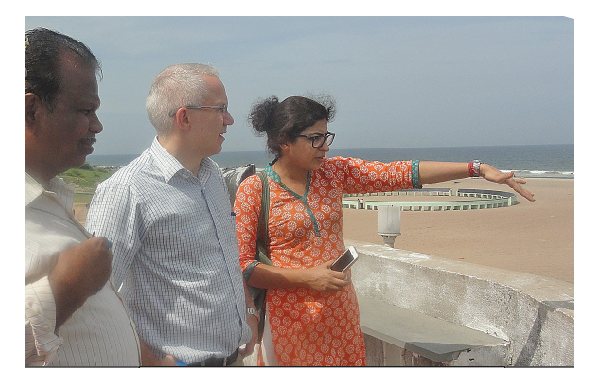Modelling shoreline changes for proposed fishing harbour
Department of Fisheries of Tamil Nadu has engaged DHI India for the preparation of the Techno-Economic Feasibility Report (TEFR) for the renovation and modernisation of the existing fishing harbour at Mudhu Nagar in Cuddalore District. With the TEFR, the Department will be able to assess the practicality of the construction, weighing financial costs as well as other factors to the potential benefits reaped from the new development.
Through numerical modelling studies carried out using MIKE Powered by DHI’s suite of modelling software, the hydrodynamics and sediment transport features for the area are resolved in the simulations, conducted both with and without the proposed harbour facility. At the same time, the sediment transport forced by currents and waves were also simulated.

DHI site visit to proposed construction site © DHI
Construction of fishing harbour may cause considerable changes in the shoreline and often result in coastal erosion or accretion, depending on the dominant processes acting on the coastline. Hence, to mitigate the impact of construction on the shoreline, sediment transport capacities were investigated by applying the littoral drift module (Litdrift). Litdrift plays an important role in deciding the areas of shoreline erosion and accretion, in shaping and orienting coastal landforms and finally in the evolution of the shore.
The Litdrift results obtained from the study show that the wave driven transport is primarily confined to the inner section of the beach where the main wave breaking occurs in water depths less than 5m mean sea level (MSL). The prevailing waves are from the South East-East directions compared to the North-South directed coastline, leading to a significantly smaller amount of wave energy reaching each length of coastline. This thus helps mitigate the strain on the coastal shores.
 Littoral transport due to sea and swell wave show the southward transport (light blue), the northward transport (red) and the net transport (green). © DHI
Littoral transport due to sea and swell wave show the southward transport (light blue), the northward transport (red) and the net transport (green). © DHI
With the results from the TEFR study conducted, the Department of Fisheries can better decide the feasibility of the project given the data gleaned from the study.
Read more